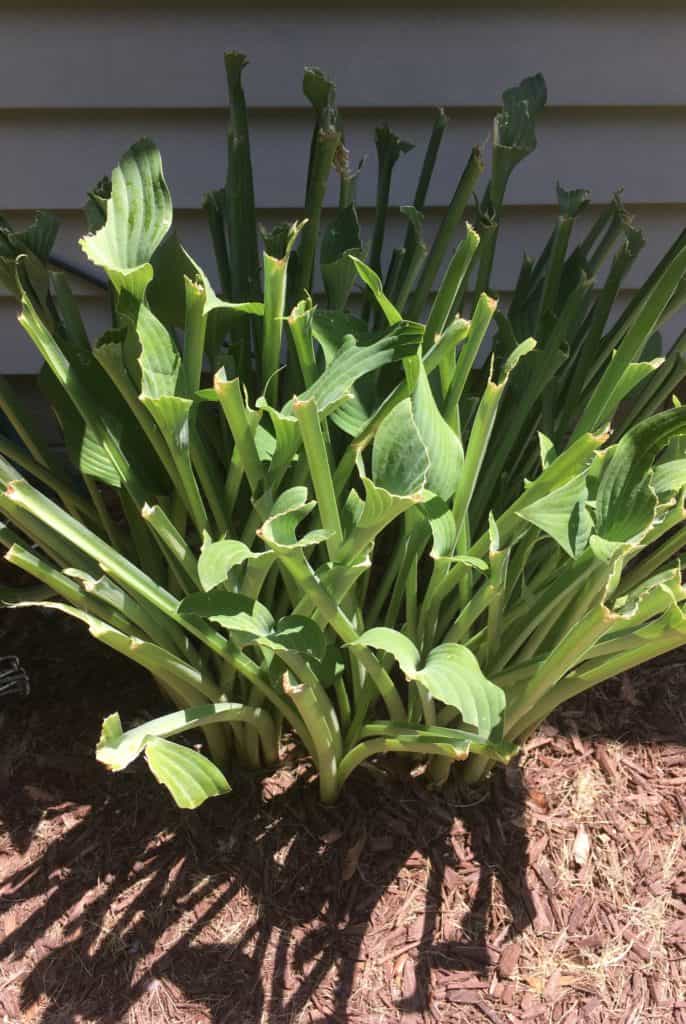Do deer eat hostas? The short answer is yes. While deer will eat just about any vegetation in desperate circumstances, hostas undoubtedly top the list as one of their favorite foods. Both North Carolina State University and Michigan State University confirm that hostas are a frequently damaged plant by deer.
Table of Contents
Evidence of Damage

You can see the damage that a deer has done to a hosta plant in my yard. We have had the plant in the same location for a few years in hopes that the deer will leave it alone. Each year in June, the plant is destroyed by a deer just as the plant begins to approach its peak of beauty.
Yes, the deer plant damage has been highly frustrating, but there are ways that we could have prevented the damage had we wished to do so. We have opted not to protect this hosta because an unprotected vegetable garden sits adjacent to the plant. While the deer have decimated the hosta, they have mostly left the garden alone. Had the hosta not been there, potentially the garden may have been the victim of browsing deer.
How to Keep Deer Away from Hostas
Location
Where you plant your hostas can make all the difference. At dusk, the deer emerge out of the woods across the street from my house and head to my neighbor’s yard to feed on some sort of seed he lays out. They then occasionally make their way onto the north side of my property where the destroyed hosta picture above is located. They then typically move back into the woods.
We have another hosta located on the south side of the house that has never been touched by deer. Of course we do not have 24/7 surveillance on this area, but after almost a decade living in this home we have never seen a deer there.
Before you plant hostas, try to observe the common routes that deer travel in your yard. Plant hostas only in areas that you believe deer will not encounter them.
Repellants
Deer repellants can be effective at deterring deer if the directions are followed fully. They often have to be applied frequently to maintain their effectiveness. Repellants are often made with ingredients that smell/taste awful to deer. The repellant is sprayed onto the plant to make it less appetizing for deer to eat. Some popular products that are known to work are Deer Out, Bobbex, Deer Stopper, and I Must Garden.
Other products that can be used to repel deer are motion-activated sprinklers, ultrasonic repellers, and light scares. These work efficiently because of the skittish nature of the animal.
Netting
A plastic mesh netting is an excellent option to deter deer. It can be installed by either draping it over the plant and securing it down or by installing tall post and creating a cage around the plant. The highly rated De-Bird Garden Netting is an example of a product that can be used for this purpose.
The downside is the appearance of the netting. Most people want an unobstructed view of their plants. This is especially true for greenery that is added to the landscape to increase the yard’s beauty. If you have the time, you could consider covering the hostas only from dusk to dawn when deer are most active.
Fencing
A fence around the perimeter of the yard is often cited at the best option for warding off deer. A yard that deer are unable to access is obviously one that is safe from deer destruction.
The fence must be high enough so that deer can’t hop over it. Deer are amazing jumpers. We are talking eight feet of jumping ability. The fence must be at least this high to keep out deer.
The University of Vermont explains that a deer fence can be lower if it is slanted or if there is another fence of similar height behind it (i.e. two six foot fences parallel to each other). We suggest checking out their article on effective deer fences if you are considering this as an option.
The disadvantage of a fence is the cost. Instead of paying a couple of grand for a fence on average, you may just opt to landscape with plants that deer seldomly eat. This list from Rutgers University can be used to determine the plants that are rarely damaged by deer. The list also reiterates the fact that hostas are not ideal for planting where deer a present.
<<<RELATED>>> Do deer eat pumpkins?
Natural Barriers
You can often protect hostas or other frequently damaged plants by creating a natural barrier around them. This may mean planting several rows of plants that deer do not prefer in front of the hostas. Things like smelly herbs, mint, and garlic work best. The deer browse around the front line of this nonpreferred vegetation and move on before ever reaching the more preferable hostas tucked away in the back.
Unnatural Barriers
Unnatural barriers can provide solid protection from deer. The below picture shows a hosta that is tucked between an angle of the house and an air conditioning unit. This hosta has been untouched by deer for a few years. However, the hosta directly in front has been destroyed by the deer as pictured.

Strategically placing hostas around unnatural barriers can save them from annihilation. They may not be ideally located in certain circumstances, but at least there is a chance for the plant to remain unharmed.
Conclusion
Areas with high deer traffic require a battle plan to combat browsing deer. This is especially true if you plan on landscaping with frequently damaged plants by deer or even occasionally damaged ones such as hydrangeas. The above tips to deter deer should help provide much better odds of deer leaving your plants alone.

